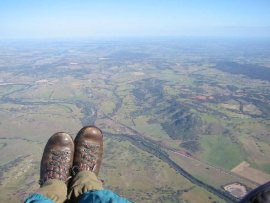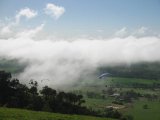Western Australia > Wheatbelt
Noondeening Hill
Contact Cloudbase Paragliding Club or the Hill Flyers Club to check on the current access arrangements. This site is privately owned, and the current owners have not granted permission for pilots to enter or fly from their land.

| Type | Inland Ridge |
| Conditions | NE |
| Height | 500ft / 150m agl |
| Rating | PG: Supervised with Advanced Supervision / Intermediate with Site Induction; HG: Supervised with Intermediate theory + 15 hours |
In the Avon Valley halfway between Toodyay and Northam. Be very careful driving, the owners request that you keep your speed right down and your eyes open because they ride motorbikes on the property. Heavy gravel trucks also use the road. Camping: The owners are quite happy for club members to take advantage of this great site and camp over. Please ask permission first, leave no rubbish and drive carefully on the property.
Landowners
Private
Contact
HGAWA , Hill Flyers (0412 611 680)Responsible
HGAWADescription
A fairly heavily wooded NE site which offers a combination of ridge lift and thermals. Can be a good site but can also be difficult due to the trees, and the takeoff location at the head of a gully. The farm's owners, Bruce and Carolyn are generally very supportive of flying and other recreational activities on their property.
Flight
This site offers a great bomb out for beginners and challenging thermal flying for more experienced pilots, however the site has the potential to be dangerous. Be sure to follow free flying's number one rule: Don't fly alone. It is essential to have an intermediate or advanced pilot give you an induction on this site.
The take-off is at the head of a long gully behind the lower part of the front ridgeline and can be subject to serious turbulence if the wind is not straight up the gully. Always be certain of the true wind direction before taking off. It is very easy to be tricked at this site as the wind can be coming more from the N or E and it will still seem on take off as if it is coming straight up the face. It is at these times that the most danger exists. Always check the direction on the ground, then go to the N end of the ridge (at a high - clear point) and get an accurate wind direction. Do not take off if the true wind is not blowing directly on the take-off.
The large paddock in front of takeoff makes for a good landing area for paragliders when not in crop, but it does have a substantial slope and is full of large rocks. If on a paraglider allow for the extended glide. If you are flying a hanglider it is recommended to land in the flatter smoother paddock to the left of the house, the same paddock should be used by paragliders when the other paddock is in crop, check for crop before driving up the hill.
Top landing is difficult and dangerous. There are clear areas behind the ridge where it is possible to land if trapped, but the landing is very committing and there may be significant rotor. On the day you fly check for the owner's preferred landing sites, which may vary with location of livestock.
The ridge is very convoluted and does not tend to produce good ridge lift. The location of the takeoff also concentrates winds and makes launching a paraglider difficult when there is enough lift to ridge soar. Usually there will be lift on the windward side of the spurs if the wind is a little cross. This site catches the morning sun and often produces good thermal activity early in the day, which can be good for a long xc with an early start, or deposit you on the ground a few km behind the hill because nowhere else has started working.
In light wind conditions thermals will tend to break off at the tree line at the base of the hill and not come through takeoff at all. A nil wind launch can be very rewarding if you time it right to hit a thermal in front (watch for trees moving, eagles, and other pilots you persuaded to go first).
The site can frequently produce valley release type thermals in the late afternoon, where there is lift everywhere on the whole length of the ridge, but it requires a bit of luck to be in the right place at the right time, nonetheless several pilots have experienced their first taste of serious thermalling here in such conditions.
The Northeasterly wind is also often strong in the morning before dropping dramatically around 10 o'clock.
Site Records: PG: Open distance- 113km, Mike Dufty, Oct 2000; Triangle- 29km, Mike Dufty, Mar 2000; Out and Return- 16km Dave Humphrey 2001. HG: ?

Hazards / Comments
As with all inland sites, thermals can generate considerable turbulence and heavy sink. Maintain adequate clearance at all times. The trees extend far in front of the hill in places, and care must be taken to ensure you always have a safe glide to landing in case of heavy sink. The location of launch at the back of a gully makes it very hazardous in a cross wind and makes determining the true wind direction difficult. Seek advice from a pilot experienced at the site if unsure of conditions on take off.